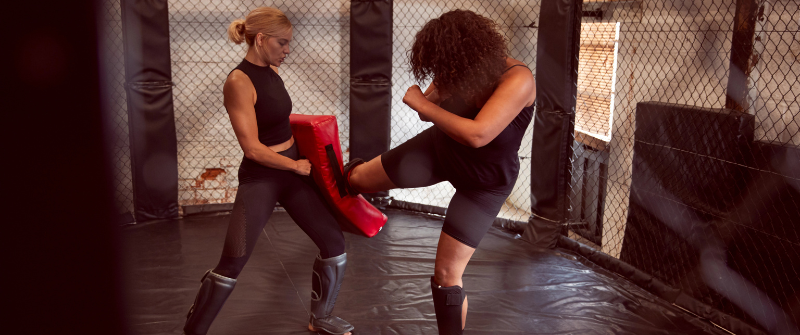
- by NEXO Team
- August 20, 2025
Women-only Brazilian Jiu-Jitsu (BJJ) classes are seeing steady growth as more women seek out fitness spaces that feel comfortable and supportive. These classes give students a way to build up their confidence, connect with others, and train without added pressure. For gyms, they offer a chance to create a more inclusive environment and bring in new members who might not have walked through the door otherwise. As these programs expand, it’s important to make clear plans around safety and liability to protect everyone involved and keep classes running smoothly. Ahead, we’ll cover how to build inclusive classes, keep students safe, and manage risk without losing sight of what makes BJJ so rewarding.
Why Women-Only Classes Matter
Women-only BJJ classes give students who may feel uncomfortable in co-ed settings a more approachable entry point. For a lot of women, the idea of training in close contact with unfamiliar men is intimidating, especially without prior experience in martial arts. A women-only space helps ease that pressure and creates a training environment that feels more relaxed and confidence-building right from the start.
These classes also create opportunities for gyms to reach audiences that might otherwise stay on the sidelines. Women who were curious but hesitant are more likely to sign up when they see a space that’s designed with them in mind. Over time, this can lead to a more diverse member base, stronger word-of-mouth, and a community that feels more connected through shared goals and experiences.
Also Read: How to Manage Your Time Effectively as a BJJ Gym Owner
Creating an Inclusive and Welcoming Atmosphere
A welcoming atmosphere starts with thoughtful leadership. Having a female instructor, or pairing new students with experienced women, may help newcomers feel more comfortable as they learn the basics. That early connection eases nerves and helps students feel supported as they settle into class.
Culture plays a role, too. Language that’s respectful, policies that support inclusion, and an environment where everyone feels valued all shape the tone of the room. Students are more likely to keep showing up when their training experience feels positive and approachable. Blending technical instruction with moments of encouragement, laughter, or casual connection helps people stay engaged. When the space feels simultaneously challenging and supportive, students build skills while also forming relationships that keep them coming back week after week. That balance is what helps a program grow over time.
Safety Considerations for Women-Only BJJ
When safety is a top consideration during class planning, students are able to train more comfortably and stay present throughout the whole session. Warm-ups should ease people into movement without putting too much strain on the body, especially for those who are just getting started. Drills that emphasize control, timing, and body awareness tend to reduce the risk of common injuries. Clear guidelines around partnering also help, since pairing students with similar size or experience levels may lower the chance of accidents during sparring.
Additionally, it’s important to explain tap-out etiquette in a way that normalizes tapping early and often. Students should feel free to set boundaries without hesitation, no matter where they are in their training. Reinforcing that mindset early creates a culture where people look out for one another. Safety then becomes part of the routine, not something that’s addressed only when problems come up.
Also Read: 6 Key Jiu-Jitsu Gym Business Plan Provisions
Risk Mitigation for Gym Owners
Running women-only BJJ classes comes with certain responsibilities, especially when it comes to safety and liability. Putting the right systems in place protects both your students and your business. The following areas are worth reviewing before launching or expanding any program.
Insurance Coverage
Standard gym insurance doesn’t always cover the specific risks that are involved in martial arts, so you should look for policies that are designed for BJJ or combat sports. It’s also important to confirm that your policy includes women-only classes, special events, and any guest instructors you may bring in.
Waivers and Documentation
Every student should complete a clearly written liability waiver and informed consent form before participating. These documents should clearly spell out the risks involved in training and make space for students to disclose any health concerns or limitations.
Instructor Training and Background Checks
All coaches should be trained in basic first aid, injury response, and safe instructional practices. In women-only classes, it’s especially important to make sure instructors understand boundaries and can create a space that feels respectful and professional.
Emergency Preparedness
A calm, clear response during an emergency starts long before anything actually goes wrong. Having a written plan for handling injuries, medical situations, or unexpected events allows staff to stay focused under pressure. Everyone on the team should know exactly what steps to take and where to find any supplies they might need.
Marketing Women-Only BJJ Classes Responsibly
The way women-only BJJ classes are marketed often shapes how approachable they feel. Messaging should highlight growth, connection, and skill-building rather than focusing on fear. Many women are drawn to the idea of learning in a space that supports them, not one that’s presented as a reaction to something negative.
Testimonials bring that message to life, and hearing directly from current students makes the experience feel more relatable while building trust. Social media is also a valuable tool, especially when it’s paired with local outreach efforts like community events, open mats, or partnerships with women-centered organizations. Promotions should emphasize that beginners are welcome and that safety, respect, and support are all part of the culture. That kind of clarity helps potential students feel more confident walking through the door.
Also Read: Top 5 BJJ Gym Marketing Tips
Long-Term Retention and Program Growth
Retention grows when students feel connected to both the training and the community around it. Experiences such as women-focused workshops, seminars, and open mats add variety and create new opportunities for members to learn, share, and build relationships with each other. Events like these also keep the energy in the program fresh, especially when they’re tied to progress or shared goals. Small touches like post-class hangouts or themed training nights help students feel more at home as well, which makes them more likely to stick with it.
As students build confidence, some may feel curious about stepping into co-ed classes. Offering a flexible path for that transition (without pressuring anyone) gives them the freedom to explore while still preserving the value of women-only spaces. Checking in regularly through feedback guides the direction of the program and keeps it responsive to the group’s needs. When people feel like their input matters, the program is able to grow in a way that stays connected to what made it so meaningful in the first place.
Conclusion
Women-only BJJ programs support growth, safety, and inclusion when they’re built on thoughtful planning and a culture that feels respectful and welcoming. Taking the time to address risk, both on and off the mats, helps protect your students while keeping your business on steady ground. If you’re considering starting or expanding a program, it’s a good idea to revisit the systems you have in place. NEXO offers specialized coverage and hands-on support to help gym owners move forward with clarity. Apply today to get insurance that fits your needs.
Categories
Fill out a short form to contact us with your questions or to receive a customized quote.
Recent Posts
-
 NEXO’s Affinity Program: How Fitness Suppliers and Associations Can Partner for Profit and Protection
December 5, 2025
NEXO’s Affinity Program: How Fitness Suppliers and Associations Can Partner for Profit and Protection
December 5, 2025 -
%20(1).png) How to Insure an MMA Gym Without Paying for Coverage You Don’t Need
December 5, 2025
How to Insure an MMA Gym Without Paying for Coverage You Don’t Need
December 5, 2025 -
 Mastering Liability for Jiu-Jitsu Tournaments and Martial Arts Events
December 5, 2025
Mastering Liability for Jiu-Jitsu Tournaments and Martial Arts Events
December 5, 2025 -
 From Zen to Zoning: What Every Yoga and Pilates Studio Owner Should Know Before Signing a Lease
December 5, 2025
From Zen to Zoning: What Every Yoga and Pilates Studio Owner Should Know Before Signing a Lease
December 5, 2025 -
%20(1).png) Why Your Referral & Loyalty Program Can Impact Your Insurance Rates
December 5, 2025
Why Your Referral & Loyalty Program Can Impact Your Insurance Rates
December 5, 2025
